Aloe vera is a sturdy succulent that can thrive with low maintenance. However, some mistakes from your end can cause black leaves or black spots on the leaves of your Aloe. It is a serious problem that requires immediate attention.
Overwatering is the primary cause of black leaves in the aloe vera plant. Poor soil and not enough drainage holes can also lead to overwatering. To prevent black leaves in aloe vera plants, use well-drained soil, check the soil before watering, and only water the plant when the soil is dry.
In this article, I will discuss the possible reasons behind black leaves on your aloe vera plant and how you can deal with it. So, keep reading.
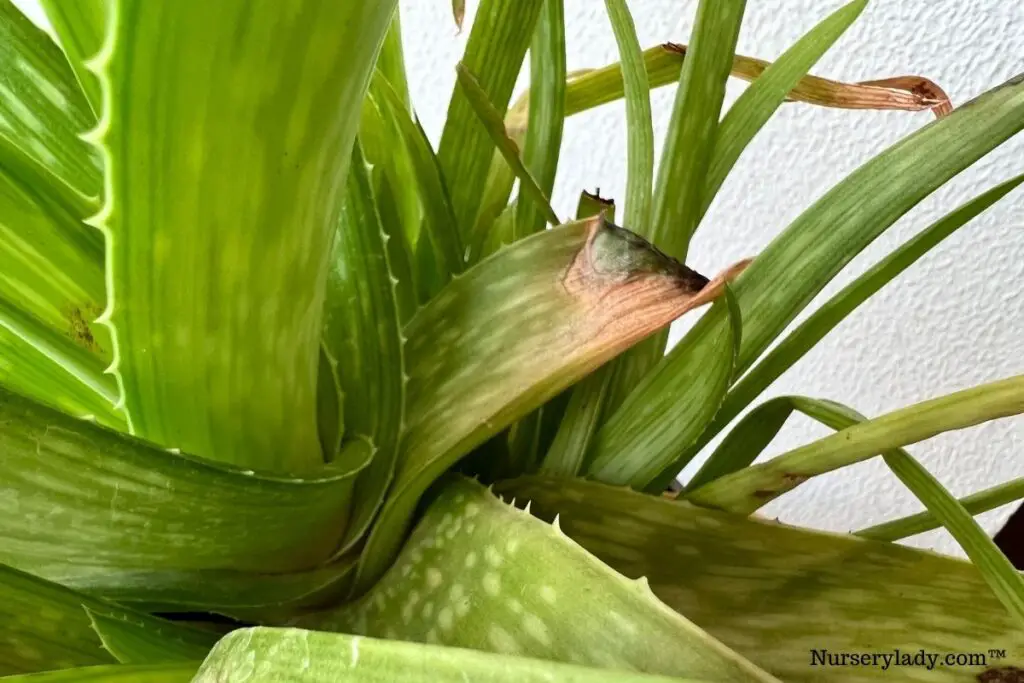
Why is my Aloe vera turning black?
Aloe vera is known for its fleshy green leaves.
Noticing them go black is a clear sign of some underlying problem.
So let’s take a look at all the possible reasons that make your Aloe vera leaves go black.
Overwatering
Aloe vera is a tropical succulent.
When people fail to realize that succulents don’t need as much water as tropical foliage plants, they overwater their Aloe.
Due to its origin, plant owners make the mistake of watering their aloe vera as frequently as they would for their other tropical plants.
They don’t realize aloe vera is succulent, so it prefers a drier condition.
Overwatering is also the result of watering a plant without checking its soil.
If you follow a watering schedule blindly while watering your aloe vera, you might end up overwatering it.
The initial signs of overwatering are yellow or brown leaves.
But when it reaches an advanced state where the roots start rotting, and the soil gives out a foul smell, the leaves start turning black.
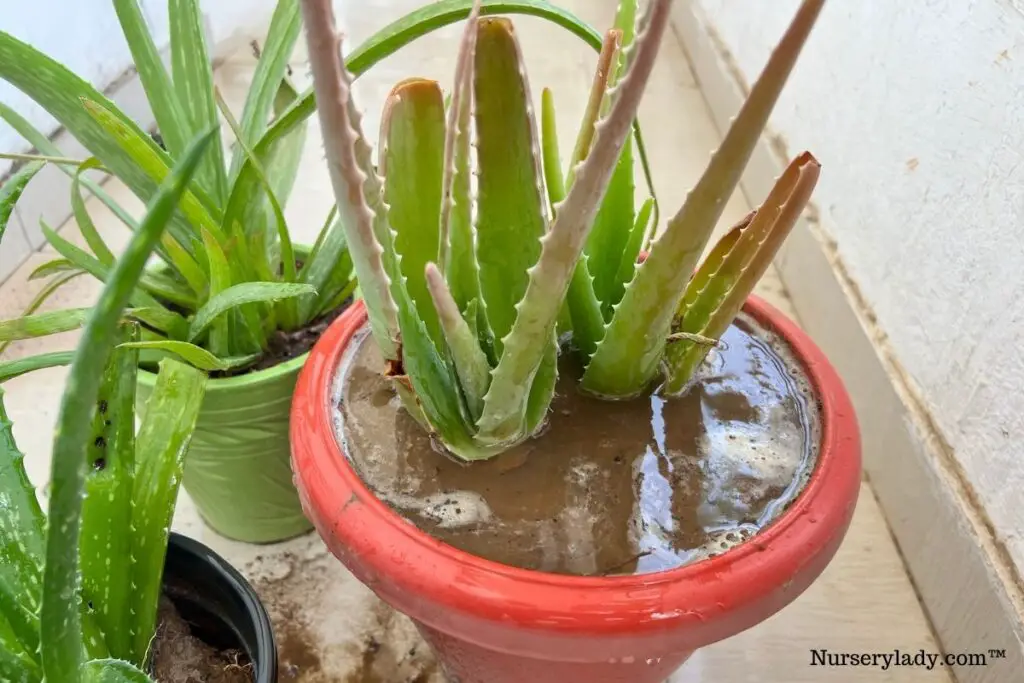
How to fix an overwatered Aloe vera?
I already told you that when you start noticing black leaves on your aloe vera due to overwatering, it has reached the level of root rot.
- First, take your aloe vera out of its pot.
- If the soil is giving out a foul smell, discard it.
- Inspect the roots and prune all the damaged and decaying ones.
- Prune the black leaves and leave only the healthy ones on the plant.
- If there are no healthy roots, you will need to discard the plant and start with a new one.
- If you notice healthy roots, you can spray fungicide on them and repot the plant in a fresh succulent mix and a new pot.
- Place the pot in a bright spot with direct sunlight and avoid fertilizing till you notice new growth.
- Use a well-drained soil mix and make sure the pot contains drainage holes.
Also read: How To Water Aloe Vera Plant? (How often, Summer, Winter)
Underwatering
Underwatering is another common mistake that can cause black leaves when you neglect your Aloe vera for an extended period.
Although Aloe vera can handle dry conditions very well, it will not survive with no water at all.
Aloe vera requires less water as it is succulent and stores water in its leaves, but that does not mean you will not give it water for months.
The most common sign of an underwatered aloe vera plant is brown and crispy leaves.
When you don’t notice such leaves or ignore your Aloe vera even after noticing the brown leaves and compact soil, you dehydrate the plant drastically and set in on the path of black leaves.
When the roots don’t get enough water, the plant’s sap can’t reach all parts and carry the water and nutrients to those areas.
All these cause various problems, including black leaves.
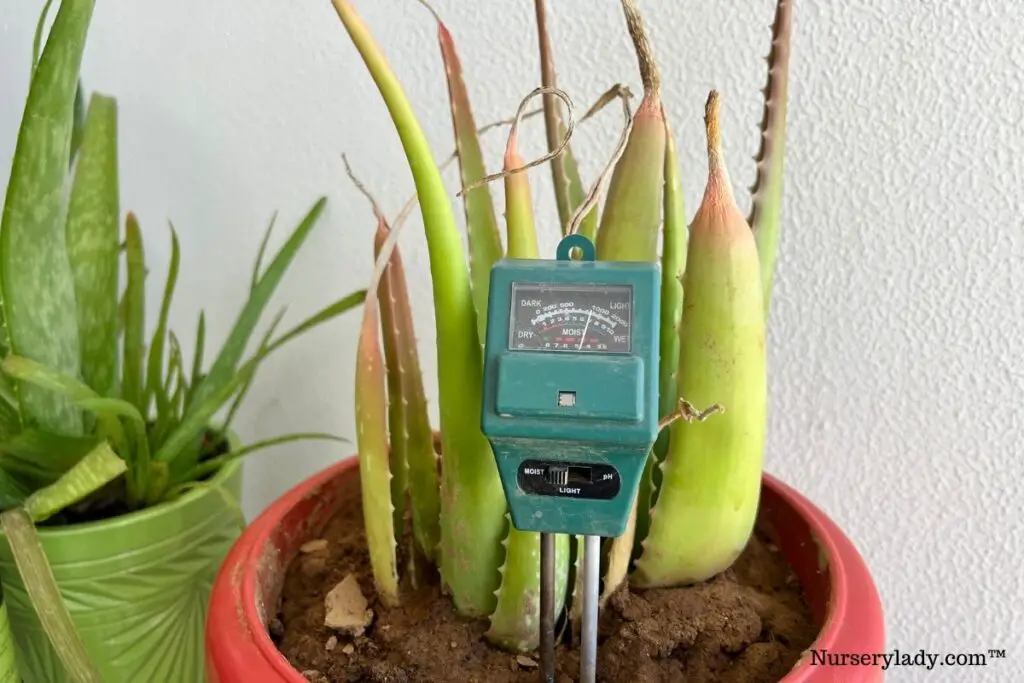
How to fix an underwatered Aloe vera plant?
- First, prune all the leaves that have turned black or are damaged. These leaves will not turn healthy and only waste the plant’s energy.
- If your Aloe is getting exposed to too intense sunlight and getting dehydrated due to that, you need to relocate it to a less bright spot.
- If the soil is too compact, try aerating it by poking holes into it with a chopstick.
- Then, give some water and let the plant absorb it. After that, you can water the plant thoroughly until the water starts draining from the bottom of the pot.
- If you can take the Aloe out of its pot, do it and place it in a tub or container filled with water and leave it like that for a few hours. After the soil absorbs the water, you can shift it back to the pot.
- Use a calendar to remind you to check on your Aloe vera, and whenever the soil goes dry, water it.
- In general, an aloe vera requires water once in 2-3 weeks in the growing period and once in 4-5 weeks in the dormant period.
Looking for gardening supplies? We have tested 100's of products before recommending them to you guys. Check out our best pick below:
| Image | Gardening Supplies | Best Price? |
|---|---|---|
 Top
Top Top
Top | Raised Garden Bed Kit | Check On Amazon |
 | XLUX Soil Moisture Meter, Plant Water Monitor, Soil Hygrometer Sensor for Gardening, Farming, Indoor and Outdoor Plants, No Batteries Required | No Results |
 Top
Top Top
Top | 82 Pcs Garden Tools Set and Extra Succulent Tools Set | Check On Amazon |
 | Joeys Garden Expandable Garden Hose with 8 Function Hose Nozzle, Lightweight Anti-Kink Flexible Garden Hoses, Extra Strength Fabric with Double Latex Core, (50 FT, Black) | No Results |
 Top
Top Top
Top | Dual Chamber Compost Tumbler | Check On Amazon |
 Top
Top Top
Top | Sunnyglade Plant Stakes | Check On Amazon |
 Top
Top Top
Top | Organic Cold Pressed Neem Seed Oil | Check On Amazon |
 Top
Top Top
Top | Mighty Mint Gallon :-Insect and Pest Control Peppermint Oil | Check On Amazon |
 Top
Top Top
Top | Scotts DiseaseEx Lawn Fungicide | Check On Amazon |
 Top
Top Top
Top | Jacks Classic 20-20-20 All Purpose Fertilizer | Check On Amazon |
 Top
Top Top
Top | 30,000 Seeds Pollinator Attracting Wildflower Mixture | Check On Amazon |
 Top
Top Top
Top | Survival Vegetable Seeds Garden Kit-Over 16,000 Seeds | Check On Amazon |
Overfertilization
Aloe vera doesn’t require a lot of fertilizer.
It is a light feeder and can thrive with one or two fertilization sessions in a year.
However, if you don’t understand its fertilization requirement, you might end up giving it too much fertilizer.
Due to excess fertilization, the soil has excess salt build-up that gets carried to different parts.
This is the reason you notice black leaves or black stems on your Aloe vera.
How to treat an overfertilized Aloe vera plant?
Overfertilization can burn the roots of your Aloe vera, and the chances of this are higher as we are talking about an advanced sign: black leaves.
- Like the other problems, you need to remove the plant’s black leaves or black parts.
- Next, you can take your plant to the sink and wash the soil with running water. Do this 3 to 4 times to get rid of the excess salts.
- If you notice a white layer on the soil, scrape it off.
- The best thing would be to repot your Aloe vera in fresh potting mix and a new pot.
- You should avoid fertilizing the plant until it recovers and shows healthy growth.
- Avoid fertilizing your Aloe when it is dormant.
Also read: Does Aloe Vera Need Fertilizer? (How Much, How Often+Best Pick)
Excess sunlight
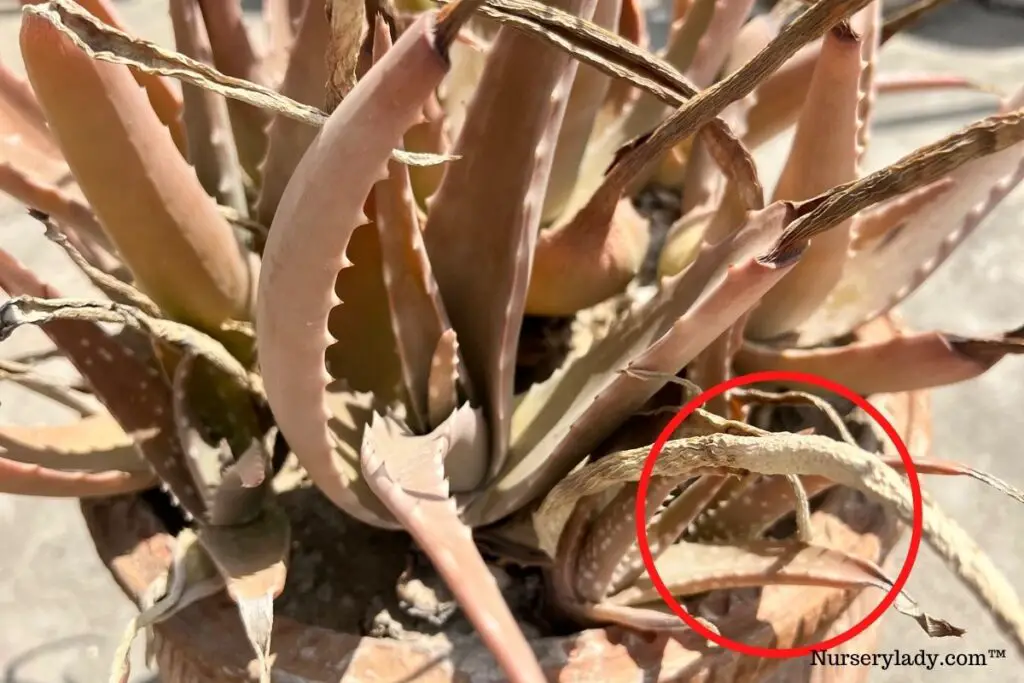
Aloe vera requires at least 6 hours of direct sunlight to thrive.
However, it will not tolerate intense sunlight exposure.
Black patches on Aloe vera leaves are signs of a sunburned plant.
If you relocate your Aloe vera to an outdoor environment from indoors, the plant can develop black spots due to exposure to the direct sun during the intense afternoons.
Relocating the Aloe vera suddenly can stress the plant and cause the black leaves.
How to treat a sunburned Aloe vera plant?
- If your aloe vera is sunburned, move it immediately to a location where it will not remain exposed to direct sunlight for too long.
- If you moved it outdoors suddenly without giving the plant time to adjust, you should bring it indoors.
- Prune all the black leaves.
- Water the plant thoroughly so it can recover from the excess sun exposure.
- If you want to move your Aloe vera outside, do it gradually so the plant can adjust to the changes and avoid placing it in a spot that gets too intense sunlight.
Also read: What Kind Of Light For Aloe Vera Plants? (Full sun, Shade, Or Partial Light?)
Frostbite
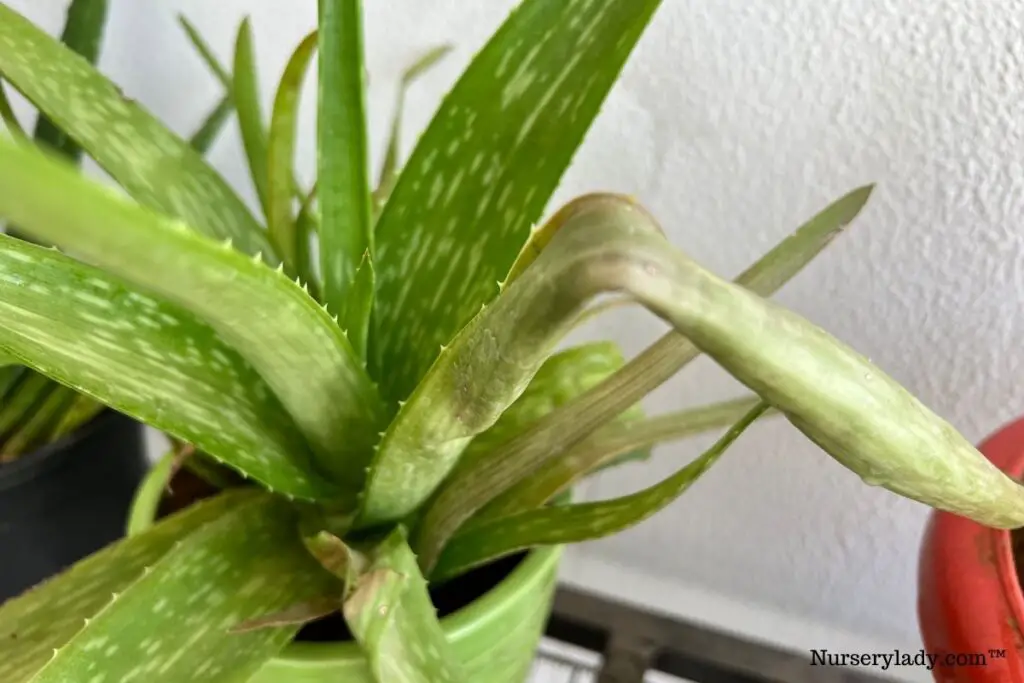
If you live in a cold region or your region receives harsh winters, your Aloe vera can be a frostbite victim.
Frostbite can damage the Aloe Vera and make the leaves go black.
When your Aloe vera is affected due to frost, the sap of the plant freezes, and it can’t carry water or nutrients to the plant.
Therefore, the plant becomes weak and shows damage as the black spots.
How to fix an Aloe vera affected with frostbite?
If your Aloe vera has turned black due to the frostbites, you can’t do anything about it as you can’t bring the damaged parts back to health.
But you can get rid of the damaged parts and bring the plant to a controlled environment to prevent further damage.
If you have potted Aloe vera, you must bring it indoors before the temperatures drop to prevent frostbites.
You must also reduce watering your Aloe vera during the wintertime.
Also read: Aloe Vera Temperature Tolerance: Ideal Temperature+Keeping Them Safe
Pest infestation
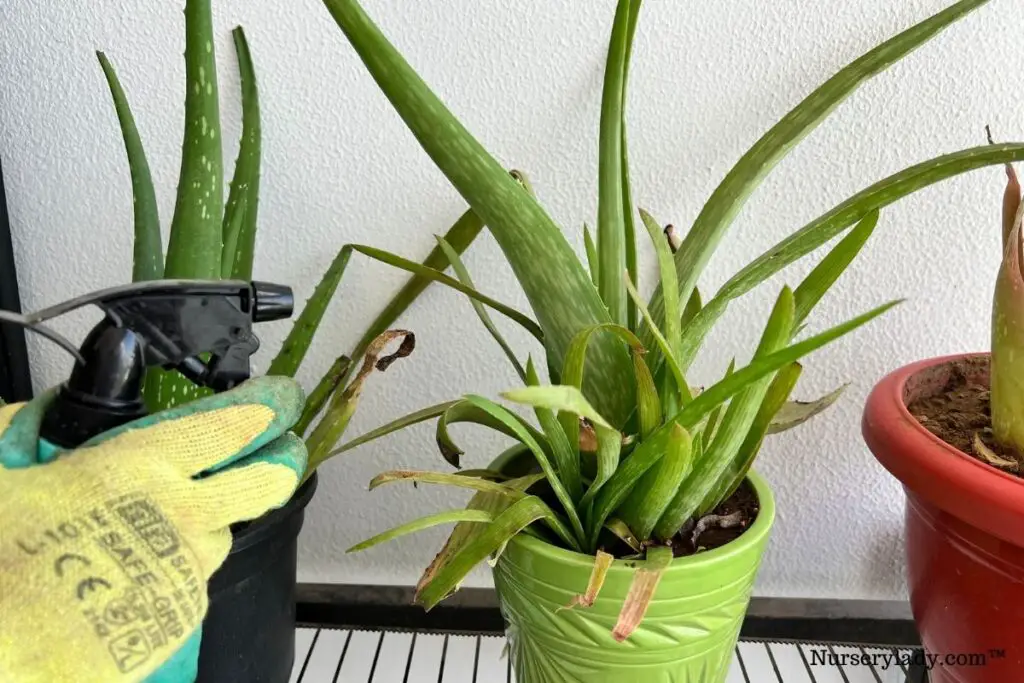
Among many problems, pest infestation can cause black spots on your Aloe vera leaves.
A pest called thrips can attack your Aloe vera and leave black spots on its leaves.
Thrips are tiny pests 1mm long that suck the sap of your Aloe vera plants and make them weak and pale.
You will usually find them in large groups around your Aloe vera.
The adult thrips have wings, while the larvae don’t have wings.
How to get rid of thrips from Aloe vera?
Follow these steps if you think your aloe vera has a thrips infestation.
- Isolate your Aloe vera plant.
- Inspect your Aloe vera thoroughly and try to find heavily infested areas that require pruning. Prune these off and discard them.
- Shower your Aloe vera with a strong stream of water.
- You can use sticky traps to attract these pests.
- Use insecticidal soap or Neem oil to treat the infestation.
Low humidity
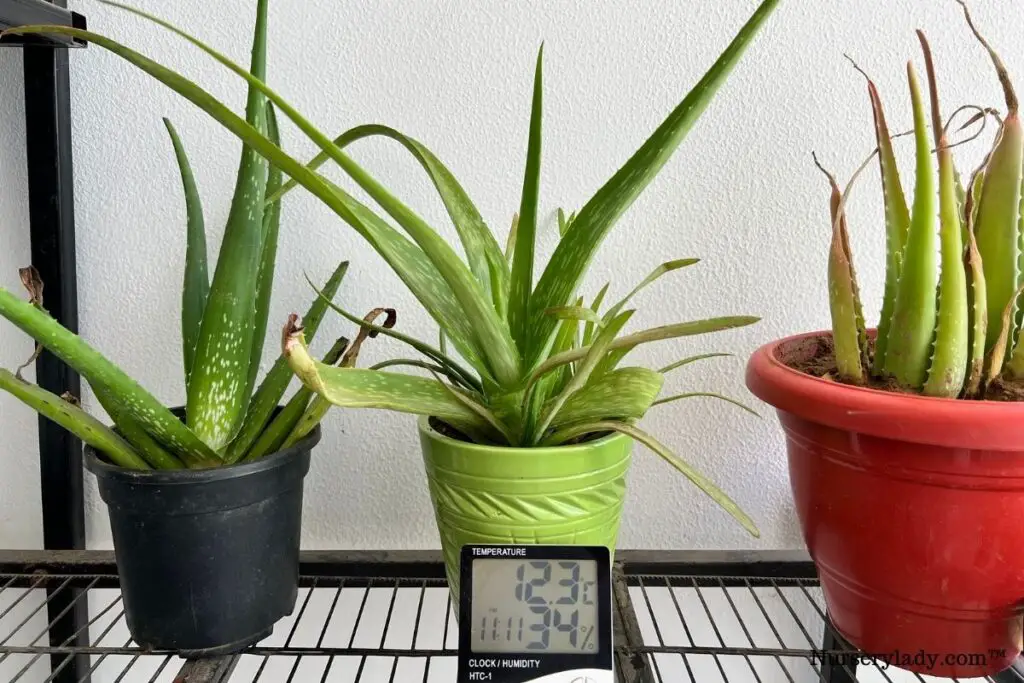
Aloe vera loves dry conditions, and it can thrive in areas with low humidity.
It can tolerate as low as 30% humidity levels.
However, exposing your Aloe vera to extremely low humidity levels for a prolonged period can result in black spots.
How? When your Aloe vera doesn’t get enough humidity, it can’t function properly.
Without enough moisture, it will start using up the moisture it retains in its leaves.
This will lead to black spots on the leaves that will droop and fall off eventually.
How to provide more humidity to Aloe vera?
Remember that you don’t need to provide high humidity levels to your Aloe vera.
An average range of 40% will be sufficient for these succulents.
You can mist the plant to raise the humidity levels around it if placed outdoors or in the garden.
If you have a potted Aloe vera plant, you can use a humidifier to maintain humidity levels of 40% around it.
Also read: Do Aloe Vera Like Humidity? (Ideal Humidity+How To Maintain)
Diseases
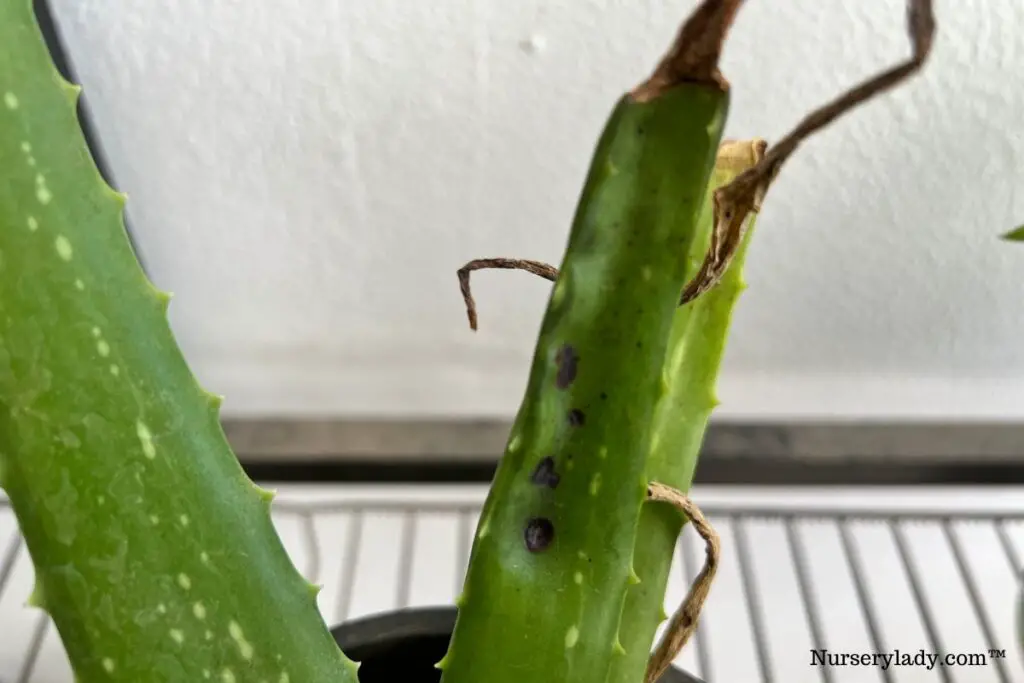
If your Aloe vera is experiencing any disease, it can develop black spots on the leaves.
Some common diseases that are found on Aloe vera plants are:
- Leaf spot disease
- Leaf blight disease
- Cladosporium leaf spot
- Aloe Vera leaf spot disease
- Aloe Vera anthracnose disease
How to save the Aloe vera from diseases?
The diseases mentioned above are caused due to bacteria or fungus growth on your Aloe vera.
- First, you need to remove the damaged parts with black spots.
- Next, you need to reduce watering your Aloe vera plant.
- Spray the Aloe with a fungicide to prevent the further spread of the disease.
But if the disease has reached an advanced level, you might need to discard the plant.
Repotting stress
It is not unusual for you to notice black spots on your Aloe vera, especially after repotting.
The succulent might have undergone some damage while you were repotting it.
This can cause severe stress to the plant, due to which the leaves can go black or develop black spots.
How to fix an Aloe vera undergoing repotting stress?
You can’t fix a stressed plant, but you can follow the correct care routine to ensure that the plant gets proper conditions.
This will help the plant recover the stress faster and become healthy again.
Also read: Does Aloe Vera Plant Like To Be Root Bound? (Possible Problems+Repot)
How do I get rid of black spots on my Aloe vera plant?
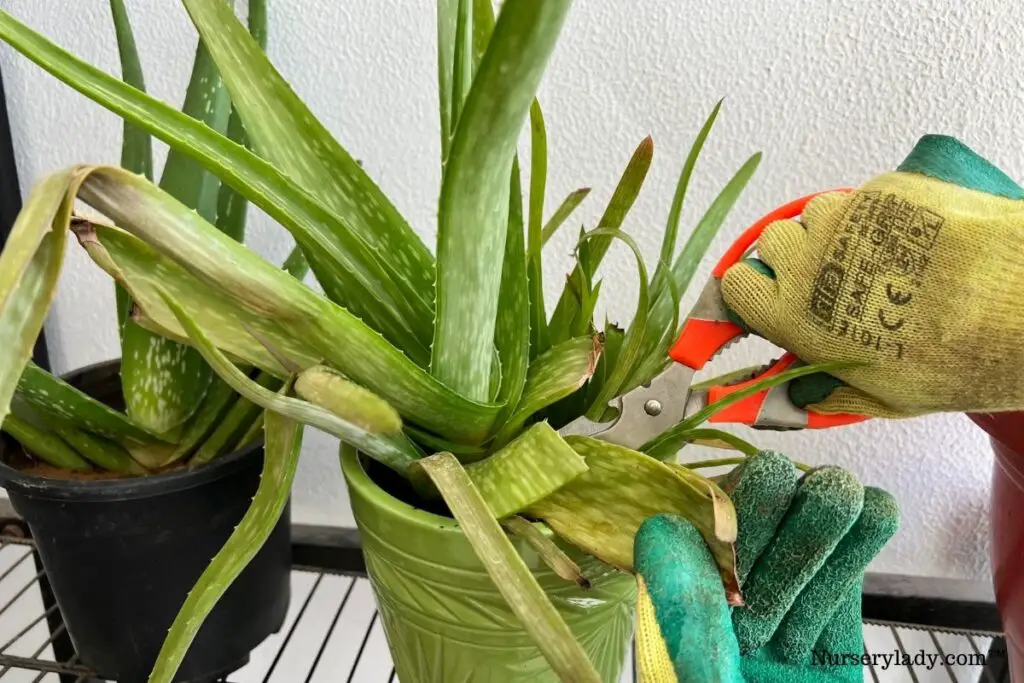
You can’t fix them once you notice black spots on your Aloe vera plants.
But, you can remove the leaves with black spots or those that have turned entirely black.
If you notice black stems or black roots on your Aloe, you should remove them too.
You can identify the problem your Aloe vera is facing and treat it so that the black spots don’t return.
Final thoughts
Black spots or black leaves on Aloe vera plants indicate that they are undergoing stress and are not at their best health.
Your job is to find out what issue is causing the black spots or black leaves on your Aloe vera and start the treatment, so they don’t occur again.
Proper research of your Aloe vera plant and providing the correct growing conditions will allow the plant to stay healthy and repel all the issues that might lead to black parts.
Reference: NCBI, New York Botanical Garden, University of New Hampshire, University of Florida, Wikipedia.

Thanks for sharing. I read many of your blog posts, cool, your blog is very good.